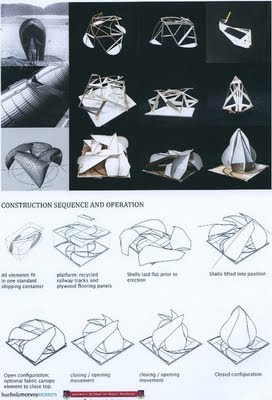Five small upside-down boats – currachs – leaning on each other with wool stretched over their hulls instead of traditional tar, creating a sheltered exhibition pavilion and performance space that can hold around 40 people. All mounted on a system of curved rails so that the currachs can twist round and close up tight like a clamshell to protect the venue at night. And designed to fit into a container on the back of a lorry for easy transportation to the next venue.

2011 has been Year of the Craft, and the Crafts Council of Ireland and the Irish Architecture Foundation decided to run a competition to raise awareness and highlight the synergies between the fields of architecture and craft. They explain:
Throughout history skilled craftspeople have worked closely with architects to create landmark buildings encapsulating exquisite design and attention to detail, and the competition is aimed at reinforcing this link.

As a result of the ‘Craftitecture’ competition, Bucholz McEvoy Architects worked in conjunction with master boat-builder Jim Horgan (Galway School of Boat Building) and precision engineers Innovative Total Solutions (Cork) to create the Cruth Curach pavilion. (‘Cruth’ is Irish for ‘shape’ or ‘construction’.)
They won the competition, and their creation has been screwed together for the first time at the Electric Picnic festival which is running this weekend. Their pavilion will host craft exhibits, music and talks during the festival before being dismantled and shipped to Open House Dublin 2011 in October.
Merritt Bucholz – one of the architects behind the project (and Professor of Architecture at University of Limerick) was speaking in Belfast at a PLACE NI lunchtime event today. You can catch a short interview with Merritt above or catch his full talk in the video at the end of this post or watch. (Note that the video brightens up two minutes in, so stick with it!)

It was interesting to understand how the very precise 3D modelling of the architecture practice worked alongside the cruder practice of boat building. Bending oak in a steam chamber is much more rough and ready than the millimetre perfect geometric design.
The five currachs (up from four in the original competition pitch) were incredibly fast to build (each took around three days) and yet were light, strong and relatively inexpensive.
Merritt commented that the Cork engineers – who supplied the blocks and rails that allow the currachs to smoothly rotate as the venue switches shape – seemed closer to craftsmen than manufacturers as they built ‘single particular devices’ to solve individual problems rather than large end-to-end solutions.

Much of modern architecture – at least the results that I see on the streets of Northern Ireland – is about straight lines, right angles, and acres of glass and concrete.
But in a fascinating comment during the question and answer session afterwards – not captured on the video – Merritt suggested that ‘we have lost the memory … of how to use timber’. Wood has become decorative and secondary, disguising its incredible strength.
If you’re down at Electric Picnic, check out the Cruth Curach pavilion and let me know what you think.
No comments:
Post a Comment